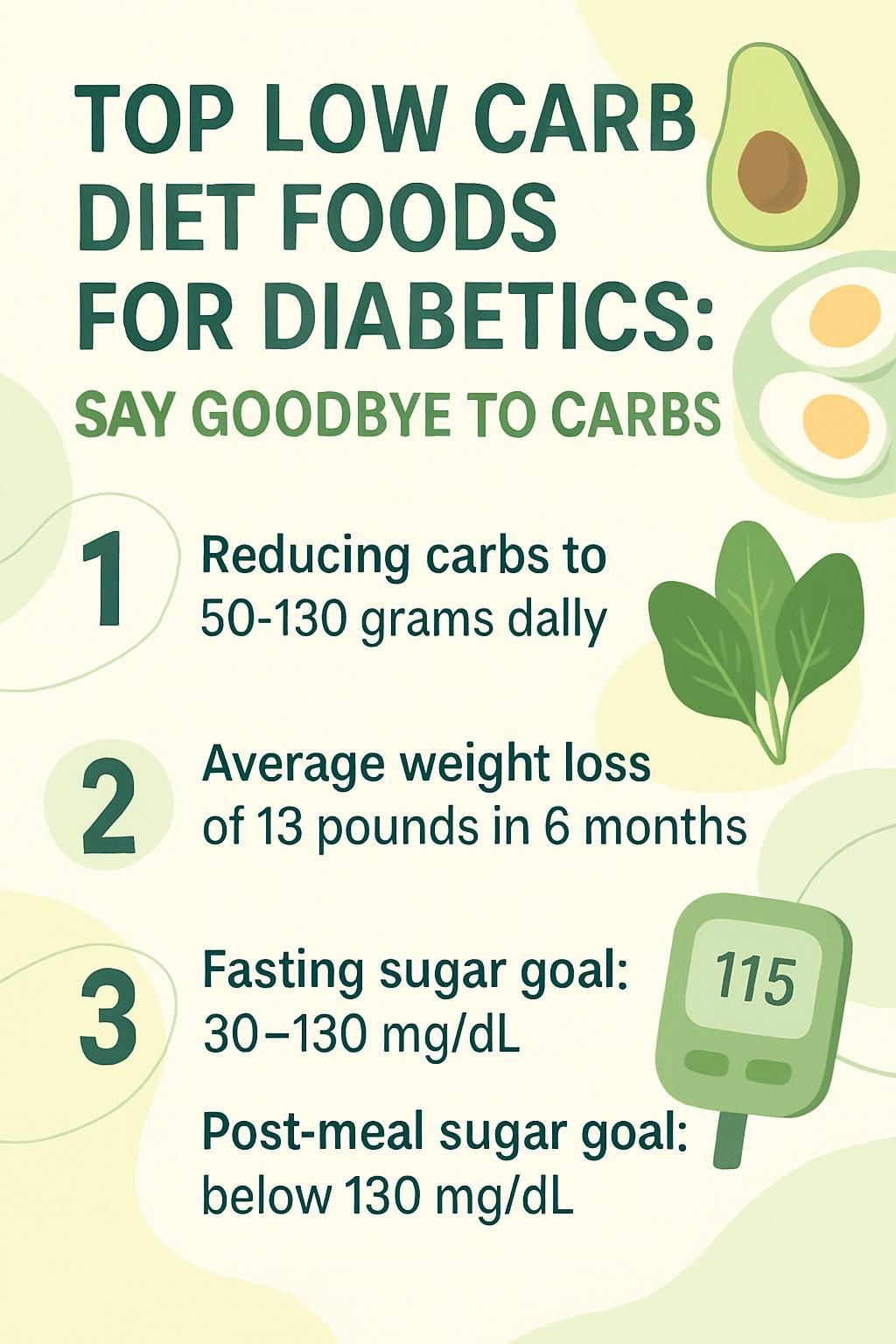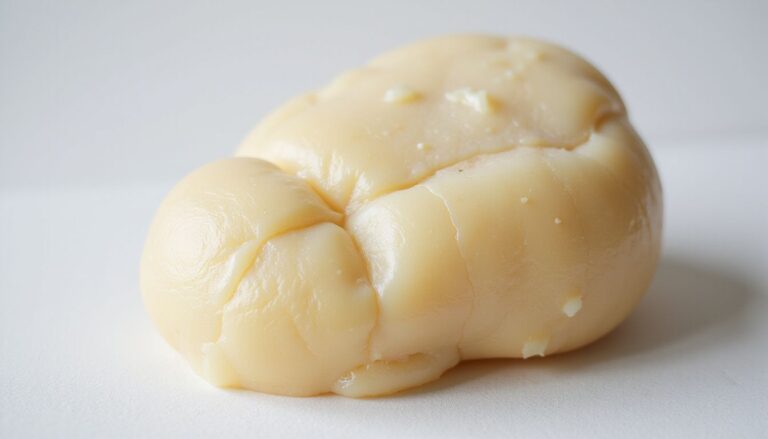Top Low Carb Diet Foods For Diabetics: Say Goodbye To Carbs!
Our Nutrition Assistant AI Suite will transform your body. You will lose fat, get toned, and build muscle. Gain confidence and optimal health.
Many people with diabetes want low-carb diet foods that steady blood sugar without feeling restricted. I know the struggle. Research shows that cutting carbs can lower blood sugar levels by as much as 20 percent for some adults.
In this guide, you will see the best carb-smart foods to enjoy on a low-carb approach, why they help with diabetes, and easy swaps for high-carb favorites. You will also find simple ideas that make healthy eating feel easier and more satisfying.
Key Takeaways
- Reducing carbohydrate intake to about 50 to 130 grams per day can lower blood sugar by up to 20 percent and A1C by about 1 percentage point for many adults with type 2 diabetes, according to the American Diabetes Association (2023). A1C is a lab test that reflects average blood sugar over three months.
- Non-starchy vegetables, lean meats, fish like salmon and tuna, nuts such as almonds or walnuts, and low-carb dairy support glucose control while meeting nutrition needs.
- Low carb plans may support faster early weight loss, with some studies showing about 13 pounds lost over six months compared with low-fat plans.
- Swapping high-carb foods for eggs, leafy greens, healthy oils like olive or avocado, berries, and avocado reduces insulin spikes and supports heart health.
- Regular monitoring helps most adults stay in target ranges, with fasting 80 to 130 mg/dL and post-meal under 180 mg/dL, as ADA guidelines advise.

What is a Low Carb Diet?

A low carb diet limits the carbohydrates in meals and snacks. It focuses on foods that are naturally lower in carbs, such as non-starchy vegetables, lean meats, fish, eggs, nuts, seeds, and some dairy products.
Foods high in added sugar or refined grains, like white bread and pasta, are replaced with more protein and healthy fats. Health experts often define low carb as 50 to 130 grams of carbohydrates per day.
This eating plan can help many adults with type 2 diabetes manage blood sugar levels. I followed a simple low-carb meal plan and cut carbs without feeling deprived at mealtimes.
Reducing daily carbohydrate consumption can significantly improve glucose control, reports The American Diabetes Association.
People tend to do well when they include higher fiber foods and reduce starches and sugars. Next, I outline key benefits of a low carb diet for diabetics.
What Are the Benefits of a Low Carb Diet for Diabetics?
A low-carbohydrate diet offers several benefits for people living with diabetes. Studies suggest that limiting high-carb foods can improve blood sugar control and overall health outcomes.
How Does a Low Carb Diet Help Regulate Blood Sugar?
Carbohydrate foods, like bread, pasta, and sugary drinks, raise blood sugar quickly after eating. When I eat fewer carbs, my blood sugar spikes less often and less sharply.
Research shows that cutting carbs can lower fasting glucose and A1C by about 1 percentage point for many people with type 2 diabetes. A1C is your average blood sugar over two to three months.
Adding protein and healthy fats from eggs, avocados, nuts, and olive oil helps me stay full and slows digestion. My energy is steadier because I avoid big highs and lows in blood sugar.
When I shifted to a lower carb approach with help from my dietitian, my daily readings after meals improved compared to when I ate grain-heavy meals. Routine checks made progress clear, along with exercise and any medicine my doctor prescribed.
Can a Low Carb Diet Aid Weight Management?
A low carb diet can help you lose weight by lowering total calories and carbohydrates. Many trials show people on low-carb plans lose weight more quickly in the first six months than those on low-fat plans.
In one study from 2020, participants lost about 13 pounds with a ketogenic diet compared with roughly 8 pounds using a standard calorie-restricted plan. Eating fewer carbs can shift the body to burn stored fat for energy instead of glucose.
I noticed less hunger between meals when I built plates with eggs, leafy greens, chicken, and fish. Weight loss can also reduce insulin levels, which supports blood sugar control for diabetes or prediabetes. At this stage, tracking net carbs, which subtract fiber from total carbs, becomes helpful because fiber has little effect on blood sugar.
Does a Low Carb Diet Reduce Heart Disease Risk?
Better weight control often improves heart health. Some studies also link low carb eating with lower triglycerides and higher HDL, the good cholesterol.
For example, a 2014 study found that people on a strict low-carb plan for one year saw triglycerides drop by about 15 percent and HDL rise by almost 10 percent. These changes matter because high triglycerides and low HDL raise heart disease risk.
Switching to fewer carbs may help the heart more than just cutting calories, said Dr. Lydia Bazzano of Tulane University.
Reducing refined foods, like white bread or sugary cereal, helped me limit carbs while keeping fiber from low-carb vegetables such as broccoli or spinach. Some evidence suggests keeping carbs under about 26 percent of daily calories can support long-term heart health, especially for adults with diabetes and excess weight.
How Does a Low Carb Diet Boost Energy Levels?
On a low-carb plan, the body uses more fat and protein for energy instead of glucose from high-carb foods. This can reduce spikes and crashes in blood sugar, leading to steadier energy during work or exercise.
Many people report less post-meal fatigue because the body taps stored fat for steady fuel. Healthy fats, like olive oil, avocado oil, nuts, and seeds, provide energy without raising blood sugar. Some studies suggest better alertness and focus with lower carb intake compared with standard high-carb diets.
Next, I explain the difference between total carbs and net carbs in simple terms.
What’s the Difference Between Total Carbs and Net Carbs?
Total carbs are the full carbohydrate count in a food. This includes fiber and sugar alcohols. Net carbs subtract fiber and some sugar alcohols from total carbs because they do not raise blood sugar the same way digestible carbs do.
For example, if broccoli has 6 grams of total carbs and 2 grams of fiber, the net carbs are 4 grams. I always check the Nutrition Facts label to see both values. Most low-carb plans suggest tracking net carbs, which gives a clearer picture of digestible carbs.
Knowing this difference makes it easier to pick foods that fit diabetic needs. It also allows plenty of room for low-carb vegetables and some fruits. Now, let’s look at the essential low carb foods that support diabetes care.
Essential Low Carb Foods for Diabetics
I focus on nutrient-dense foods that help manage blood sugar. These choices fit easily into breakfast, lunch, and dinner, and they keep meals interesting.
Non-Starchy Vegetables to Include
Non-starchy vegetables are the backbone of a healthy low-carb diet. They provide fiber, vitamins, and minerals with very few carbs.
- Broccoli has about 4 grams of net carbs per cup, plus vitamin C, folate, and potassium. I add it to stir-fries or steam it as a side.
- Cauliflower offers roughly 3 grams of net carbs per cup. It works well as a rice or potato swap and absorbs flavors nicely.
- Zucchini gives about 2 grams of net carbs per half-cup. It is great raw in salads or cooked as zucchini noodles in place of pasta.
- Spinach is rich in iron and magnesium with less than 1 gram of net carbs per cup when raw. I like it in smoothies or omelets.
- Bell peppers stay under 4 grams of net carbs per half-cup and are packed with vitamin C. They make a crunchy snack or a colorful salad add-in.
- Kale is nutrient-dense with about 3 grams of total carbs per cup raw. I use it as a salad base with olive oil and lemon.
- Arugula brings a peppery taste and vitamin K with under 1 gram of total carbs per cup. It works well in Mediterranean-style salads.
These vegetables help manage blood sugar without adding excess carbs or calories to your plate.
Broccoli, Cauliflower, Zucchini, Spinach, Bell Peppers
Broccoli delivers fiber and vitamin C while staying low in carbs. Cauliflower is a versatile swap for rice or potatoes and has about 5 grams of total carbs per cup.
Zucchini makes easy zoodles to replace pasta. One medium zucchini has around 3 grams of net carbs. Spinach adds iron and magnesium without raising blood sugar. Bell peppers bring color and antioxidants with fewer than 6 grams of total carbs per cup.
Using these vegetables helps me manage carb intake while keeping a high-fiber, healthy diet.
Leafy Greens: Kale, Cabbage, Arugula
Leafy greens like kale, cabbage, and arugula make low-carb meals more flavorful. Kale provides vitamin K with almost zero net carbs per serving. One cup of raw kale has less than 1 gram of carbs.
Cabbage is great for salads and slaws. It supports gut health with fiber and has a low glycemic index, which means it raises blood sugar slowly. Arugula adds a peppery kick with only 0.4 grams of total carbs per cup.
Some research suggests that eating more leafy greens may help lower blood sugar because they supply minerals such as magnesium and potassium. I often add these greens to omelets or use them as a base for chicken salad.
Recommended Low Carb Fruits
Like leafy greens, certain fruits fit well in a low carb plan. Berries are my top pick because they are flavorful and lower in sugar than many fruits.
A half-cup of sliced strawberries has about 6 grams of carbs. A full cup of raspberries has roughly 7 grams of net carbs. These fruits offer vitamins and fiber without sharp blood sugar spikes.
Avocados are also excellent because they have very few net carbs and provide healthy fats. Tomatoes, which are fruits, give vitamin C and fiber with about 5 grams of total carbs per medium tomato. Choosing these fruits helps me enjoy variety while keeping blood glucose steady.
Berries: Strawberries, Blueberries, Raspberries
Strawberries, blueberries, and raspberries are tasty low carb options for people with diabetes. One cup of strawberries has about 12 grams of carbs. One cup of raspberries has around 15 grams. Blueberries are a bit higher at about 21 grams per cup but can still fit in a balanced plan.
These fruits also bring fiber, antioxidants, and vitamin C. I add fresh berries to plain Greek yogurt or salads for flavor without many carbs. Some studies link berry intake to improved markers related to heart and metabolic health.
Benefits of Avocados
Avocados are rich in monounsaturated fat, which supports heart health and may improve cholesterol levels. They contain very few net carbs. Half an avocado has about 2 grams of net carbs and over 7 grams of fiber.
I feel full longer after eating avocado because of its healthy fats and fiber. That makes it easier to skip carb-heavy snacks like cake or fries. Avocados also provide potassium, which supports healthy blood pressure. Sliced avocado with eggs at breakfast gives steady energy without a blood sugar spike.
Protein-Rich Animal Products
After enjoying the healthy fats in avocados, I lean on animal proteins that add little to no carbs. Chicken and turkey deliver lean protein that supports blood sugar goals. One skinless chicken breast has roughly 26 grams of protein and almost zero carbohydrates.
Beef provides iron and zinc, two minerals that support energy and immune health. Fatty fish like salmon, mackerel, sardines, and tuna supply protein and omega-3 fats linked to better heart outcomes. Eggs are another great choice, with 6 grams of protein and under 1 gram of carbs per large egg.
Starting my day with an omelet or boiled eggs keeps me full longer than cereal or bread-based meals.
Meats: Chicken, Beef, Turkey, Lamb
Chicken, beef, turkey, and lamb are top protein choices on a low carb diet. These meats contain minimal carbs and deliver important minerals like iron and zinc.
For example, 3 ounces of cooked chicken breast has about 26 grams of protein and no carbs. Lean beef can offer omega-3s when grass-fed. Turkey is lean yet filling. Lamb provides vitamin B12 and heme iron, which support energy and red blood cell health.
Grilling or baking keeps added fat lower than frying or breading. I use simple seasonings like garlic or mustard to add flavor without extra carbs. Fish and seafood offer even more protein options with few carbs.
Fish and Seafood: Salmon, Tuna, Mackerel, Sardines
Salmon, tuna, mackerel, and sardines give me high-quality protein without the carbs found in grains or beans. These fish also contain omega-3 fats that may reduce heart disease risk.
One serving of salmon provides about 22 grams of protein and zero total carbs, along with minerals like potassium. The American Heart Association suggests eating seafood twice per week for heart and overall nutrition benefits.
Grilled mackerel or canned sardines keep my energy steady through the day. Tuna mixes easily into salads with lettuce or cucumber for a filling lunch that adds vitamin D for bone health.
Eggs as a Protein Source
Eggs offer complete protein with all nine essential amino acids. One large egg has about 6 grams of protein. Eggs also provide minerals such as selenium, iron, and zinc.
I cook eggs for a quick breakfast or grab a hard-boiled egg as a snack. Eggs have almost zero carbs, so they do not raise blood sugar. Research suggests that including eggs in a low carb plan may improve satiety, which helps with appetite control.
Nutritious Nuts and Seeds
I often snack on almonds or walnuts between meals. They are low in carbs and high in healthy fats, which can support heart health for people managing diabetes.
One ounce of almonds has about 2 grams of net carbs and provides magnesium, a mineral that supports blood sugar control. Walnuts supply plant omega-3 fats that may reduce inflammation. Chia and flax seeds add fiber without many net carbs.
Two tablespoons of chia seeds give only about 1 to 2 grams of net carbs and around 10 grams of fiber. I add them to plain Greek yogurt or smoothies for extra nutrition. Next, I look at low carb dairy options that fit many plans.
Almonds, Walnuts, Chia Seeds, Flax Seeds
Almonds, walnuts, chia seeds, and flax seeds are staples in my low carb routine. Almonds deliver healthy fats, protein, and fiber that help steady blood sugar. An ounce of almonds provides about 2 grams of net carbs and a solid dose of magnesium.
Walnuts bring omega-3 fats that support heart health. Chia seeds form a gel in liquid and offer about 4 grams of fiber with under 1 gram of net carbs per two tablespoons. Flax seeds add crunch and contain lignans, which are compounds linked to lower inflammation and improved cholesterol.
I check labels on packaged nuts to avoid added sugars or oils that do not fit a low carb plan.
Low Carb Dairy Options
After using nuts and seeds for healthy fats and minerals, I turn to dairy for more low-carb choices. Cheese is a simple snack with protein and very few carbs. One slice of cheddar has about 0.4 grams of carbs.
Plain Greek yogurt usually contains 4 to 6 grams of carbs per serving and provides probiotics for gut health. Heavy cream works in coffee instead of flavored creamers that often contain added sugar. It has less than 1 gram of carbs per tablespoon. Butter from grass-fed cows supplies vitamin K2 and keeps total carbs low.
These options can help control blood sugar thanks to their fat content and minimal impact on glucose. The American Diabetes Association continues to evaluate dairy and diabetes, but plain, lower carb options often work well.
Cheese, Greek Yogurt, Heavy Cream
Cheese, Greek yogurt, and heavy cream offer protein and calcium with very few carbs. I add a slice of cheddar or a spoonful of plain Greek yogurt to meals for more flavor without spiking blood sugar.
Most cheeses have less than 1 gram of carbohydrate per ounce. Half a cup of plain Greek yogurt has about 4 grams. Heavy cream contains almost no carbs and can enrich sauces or coffee. I always check yogurt labels since flavored versions can hide added sugars.
Healthy Fats to Include
Healthy fats provide steady energy without raising blood sugar. My regular picks are olive oil, avocado oil, butter, and coconut oil.
Olive oil is a key part of the Mediterranean diet and supports heart health. Coconut oil contains medium-chain triglycerides that the body can use quickly for energy. Avocado oil is rich in monounsaturated fats that support healthy cholesterol levels.
Butter from grass-fed cows adds vitamins like A and supports a rich flavor profile. I use these fats to replace processed oils in my kitchen. They help keep energy steady, which matters when carbs are lower.
Olive Oil, Coconut Oil, Avocado Oil, Butter
Olive oil, coconut oil, avocado oil, and butter are my go-to cooking fats on a low carb diet. Olive oil provides heart-friendly monounsaturated fats and has 0 grams of carbs per tablespoon.
Coconut oil offers medium-chain triglycerides that can boost energy without affecting blood sugar. Avocado oil brings vitamin E and mild flavor for salads or sauteed dishes. Butter adds natural richness and contains vitamins A and D.
Switching to these fats makes it easier to prepare low-carb meals and support stable glucose control. I find my meals stay satisfying without adding empty calories.
Suitable Low Carb Beverages
Water is my favorite low-carb beverage. I sip it throughout the day for hydration. Sparkling water adds variety without sugar or calories.
Black coffee has less than 1 gram of carbohydrate per cup. Moderate coffee intake may be linked with a lower risk of type 2 diabetes in some studies. Unsweetened herbal teas, like peppermint or chamomile, bring flavor without affecting blood sugar.
I skip juice and regular soda because they push carbs up fast. Replacing sugary drinks with water can lower daily calorie intake by about 200 calories for many people. For taste, I infuse water with lemon, cucumber, or a few berry slices.
Water, Black Coffee, Herbal Teas
Plain water is the best choice for hydration and has zero carbs. Unsweetened black coffee also contains almost no carbs. I enjoy a cup in the morning to start the day.
Herbal teas like chamomile or peppermint offer flavor and antioxidants without added sugars. These drinks fit neatly into a plan based on low-carb vegetables and steady routines. I often pair a warm tea with a small handful of almonds for a balanced snack.
What Are Some Low Carb Meal Ideas for Diabetics?
I like simple low-carb meals built around lean proteins, non-starchy vegetables, nuts, and healthy fats. These ideas make it easier to stay on track.
Breakfast: Veggie Omelet with Avocado Slices
A veggie omelet with avocado starts the day strong and keeps carbs low. I use spinach, bell peppers, and mushrooms in the eggs for flavor and minerals.
Avocado adds healthy fat and potassium, which can support blood pressure and stable blood sugar. For crunch, I add a few walnuts or almonds. I sometimes use a little mustard for extra taste since it adds almost no carbs.
Lunch: Grilled Chicken Salad with Olive Oil Dressing
Grilled chicken gives lean protein plus iron and zinc. Adding spinach, arugula, and kale boosts fiber without many carbs. Sliced nuts add healthy fats and texture.
For dressing, I mix olive oil with mustard or lemon juice. This meal keeps my energy steady through the afternoon because it contains minimal net carbs and plenty of nutrients.
Dinner: Baked Salmon with Steamed Broccoli
Baked salmon delivers protein and omega-3 fats, which may reduce heart disease risk for people with diabetes. Steamed broccoli adds potassium and magnesium while staying low in carbs.
A small drizzle of mustard on the salmon adds flavor without added sugar. Sometimes I serve a few almonds on the side for extra fiber and crunch.
Snack Options: Almonds or a Boiled Egg
Almonds make a smart low-carb snack. One ounce has about 6 grams of carbs, most from fiber, plus magnesium and potassium. They help keep my blood sugar steady and add healthy fats.
A boiled egg is another easy option with less than 1 gram of carbs and 6 grams of high-quality protein. It also provides iron and vitamin D. Both snacks fit well into a diabetes-friendly meal plan.
How to Start a Low Carb Diet Safely?
Starting a low-carb plan takes a bit of planning. I build meals around non-starchy vegetables, lean proteins, healthy fats, and nuts for steady energy.
Why Consult Healthcare Professionals?
Healthcare professionals help track progress and watch for side effects, especially if I use diabetes medicines. If I add more protein or change my snacks, they make sure my plan stays balanced.
Clinicians also check vitamin and mineral levels to prevent gaps that could affect blood sugar control. Regular check-ins help me adjust my plan safely under current guidelines. This article is educational and not medical advice, so always work with your care team.
How to Monitor Blood Sugar Regularly?
After meeting with my care team, I used a blood glucose meter daily. I checked before and after meals to see how different foods affected my numbers.
The ADA suggests fasting levels between 80 and 130 mg/dL for most adults, with post-meal levels under 180 mg/dL. I logged each reading with foods, portions, and activity. Reviewing this data with my doctor helped us tune my meal plan for better control.
Tips for Advanced Meal Planning
I plan a week of meals in a simple spreadsheet. I list low-carb foods like leafy greens, eggs, chicken, salmon, avocados, plain Greek yogurt, and nuts. Each day balances protein with non-starchy vegetables.
Batch cooking on Sunday helps me avoid last-minute choices that stall progress. Studies suggest that planning ahead can lower daily calories by up to 15 percent and support better blood sugar control in people with diabetes. Clear containers with labels help me track portions and freshness.
Why Avoid Processed Low-Carb Snacks?
Processed low-carb snacks often include artificial sweeteners, preservatives, and fillers that may upset digestion or nudge blood sugar higher. They also tend to be low in fiber and key vitamins.
When I leaned on packaged bars during busy weeks, I noticed bloating and higher post-meal readings compared with whole foods. Swapping to simple snacks, like almonds or boiled eggs, gave steady energy without unwanted additives.
Next, I share which foods I avoid most on a low carb plan for diabetes.
Which Foods Should Diabetics Avoid on a Low Carb Diet?
Some foods raise blood sugar quickly, even if they seem healthy. I watch these closely to keep my plan on track.
Why Avoid Sugary Beverages and Snacks?
Sugary drinks and snacks can cause rapid blood sugar spikes. Research from Harvard found that regular intake of sweet drinks, such as soda, sports drinks, or packaged juice, is linked to a higher risk of type 2 diabetes.
Even small cans or snack bags can pack more than 30 grams of sugar. I swapped my lemon-lime soda for sparkling water with citrus and felt my energy stay more stable.
Foods high in added sugar also drive cravings and weight gain, which make diabetes harder to manage. Choosing berries or nuts instead gives satisfaction without the blood sugar surge. Many guidelines suggest keeping added sugars under 10 percent of daily calories.
Starchy Vegetables: Potatoes, Corn, Peas
Starchy vegetables can raise blood sugar more than non-starchy ones. Potatoes, corn, and peas are higher in carbs than spinach, cucumbers, or broccoli.
One medium potato has about 37 grams of total carbs. Half a cup of corn has about 20 grams. Half a cup of peas has around 12 grams. Limiting these helps me stay within my daily carb goals and keep readings steady.
Many dietitians suggest swapping potatoes or corn for broccoli or cauliflower to reduce post-meal spikes. Checking labels and portion sizes helps me make better choices.
Refined Grains: White Bread, Pasta, Rice
Refined grains like white bread, pasta, and rice are high in simple carbs that raise blood sugar quickly. One slice of white bread has about 14 grams of carbs. A cup of cooked white rice has more than 45 grams.
Refining removes most vitamins, minerals, and fiber, which makes it easier to overeat and harder to feel full. Studies in diabetes care recommend limiting refined grains to improve blood sugar control and heart health over time.
Common Questions About Low Carb Diets for Diabetics
Many people have similar questions about low-carb diets. Here are clear answers based on evidence and what worked for me.
What Are the Best Low Carb Foods for Beginners?
Start with non-starchy vegetables like broccoli, zucchini, and bell peppers. Most have fewer than 5 grams of net carbs per serving. Leafy greens such as kale, spinach, and arugula are rich in vitamins A and C and contain few carbs.
Berries, like strawberries and raspberries, offer fiber and antioxidants with modest sugar. Eggs provide versatile protein without added carbs. Chicken breast or salmon give high-quality protein for muscle health with zero carbs.
I also use almonds to curb hunger between meals, with about 2 to 3 grams of net carbs per ounce. Cheese and plain Greek yogurt add calcium with minimal sugar.
Are There Nutrient Deficiencies in Low Carb Diets?
A strict low carb plan may lead to nutrient gaps if meals are not planned well. Cutting many fruits or whole grains might mean less vitamin C, potassium, magnesium, or fiber.
When I first went very low carb, I had leg cramps and felt tired. Research also notes that calcium and some B vitamins can drop if dairy or fortified grains are reduced.
To prevent gaps, I include leafy greens for iron and potassium, plus chia or flax for fiber and plant omega-3s. Many professionals suggest a daily multivitamin if you keep carbs very low long term.
What Is the Recommended Daily Carb Intake for Diabetics?
Experts often suggest 45 to 60 grams of carbohydrates per meal for many adults with diabetes. This helps manage blood sugar without big swings. I track carbs at each meal, and that habit improved my numbers.
Needs vary with age, activity, gender, and medications. Some people feel best at 100 to 130 grams per day, while others need more. For a personal target, talk with your healthcare team. Understanding total versus net carbs also helps you manage daily intake.
Conclusion
Choosing low-carb diet foods can help manage diabetes. I build meals with non-starchy vegetables, berries, lean meats, nuts, and healthy fats. These choices support steady blood sugar and provide lasting energy.
Evidence shows that keeping carbs modest can support weight control and lower heart risks for people with diabetes. Make small swaps at each meal, and track what works for you. Those simple changes, done often, add up to better health over time.
FAQs
1. What are the best low carbohydrate foods for people with diabetes?
Leafy greens, eggs, poultry, fish, and nuts offer high nutrition with minimal carbohydrates. These foods help control blood sugar levels and provide essential vitamins and minerals.
2. How do low carbohydrate diets benefit individuals managing diabetes?
Low carbohydrate diets can lower blood glucose spikes after meals. Studies show that reducing carb intake improves insulin sensitivity and helps maintain stable energy throughout the day (American Diabetes Association).
3. Are there specific vegetables that work well in a low carbohydrate diet for diabetics?
Yes; broccoli, spinach, cauliflower, zucchini, and bell peppers contain few carbohydrates while offering fiber and antioxidants. These options support healthy digestion without raising blood sugar significantly.
4. Can I still enjoy snacks on a low carbohydrate diabetic diet?
You can select cheese cubes, unsweetened yogurt made from cow’s milk or goat’s milk, hard-boiled eggs, or sliced turkey breast as snack choices. Each provides protein to keep you full without causing large changes in your glucose readings.
Summary: Low carbohydrate diets focus on nutrient-rich foods like leafy greens and lean proteins to help manage diabetes effectively. Choosing these options supports steady blood sugar control based on evidence from clinical research studies.







